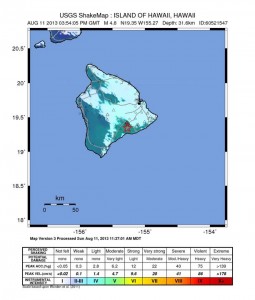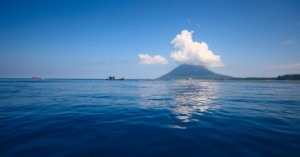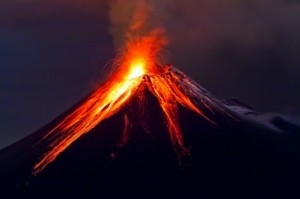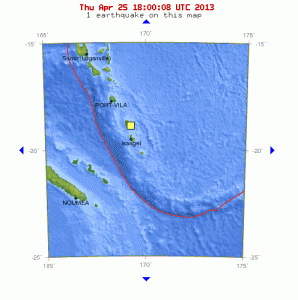
A 4.9 earthquake strikes beneath Kilauea Volcano, August 11, 2013 – USGS
A 4.9 magnitude earthquake shook the island of Hawaii, 5 miles south of the summit of Kilauea Volcano and at a depth of about 20 miles under the island. Tsunami watches went out, but no tsunami was generated – luckily.
Many “Big Island” residents felt the shaking and people as far away as Oahu and Maui reported feeling the earthquake. Over 400 reports were received within the first hour of the earthquake.
The 5.9 quake was followed minutes later by a 3.4 quake and a 2.9 quake as the activity settled down and the region reached equilibrium.
A Volcano-Quake

Underwater volcanic earthquakes should be taken seriously – especially for the residents on the island.
Wes Thelen, Hawaii’s Seismic Network Manager, said that these earthquakes were most likely structural adjustment of the Earth’s crust due to the weight of the island on the underlying mantle.
I disagree, and wonder why he doesn’t take this deeper (sorry about the pun). The Pacific Rim is more active today than it has been in recorded history, with an increase in both large earthquakes and volcanic activity.
The Earth’s oceans are warming, the crust is heating up, and the planet is shifting – big time.
This 4.9 magnitude quake under the Kilauea Volcano signals that the magma deep beneath Kilauea is moving upward. For this much movement to occur, a shift in the mantle has taken place, yes, but this is not due to the weight of the “island” – it is due to the movement of hot magma coming closer to the Earth’s surface under Kilauea.
THIS was a volcano-quake.
Take It In Stride
Sometimes I wonder if earthquake magnitudes are kept just under the mark to make the increase in magnitudes seem lower – like 4.9 amd 5.9 as opposed to 5.0 and 6.0. This sounds less threatening, right? It serves little purpose to keep the people living near an active volcano in the dark. Have you ever watched the movie Dante’s Peak?
Watch it!
Be prepared, and stay aware. Enjoy the Hawaiian paradise, but also know that things are heating up under your feet!



